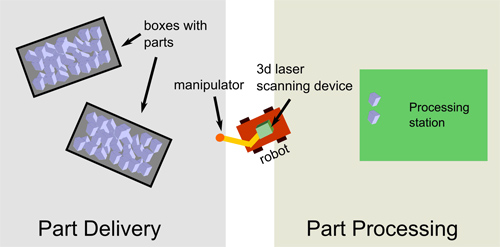Sep 27, 2011 , by
Public Summary Month 9/2011
The experiment partners continued work on object recognition, grasp selection, and motion planning for picking objects out of a transport box.
The primitive-based object recognition has been accelerated and made more robust. Now, 2D contours are also considered for recognition. The best visible object is selected.
Grasps are sampled, checked for collisions, and ranked offline. In the current situation, we check for reachability with our robot arm, collisions with the transport box and other objects, and plan reaching motions.
The components have been integrated in simulation as well as for the real robot Cosero.


Jul 27, 2011 , by
Public Summary Month 7/2011
In the ActReMa experiment, a robot delivers parts to a process station. The robot is equipped with a 3D scanning sensor. It must recognize objects in a box and grasp them.
The experiment partners started their work according to the plan. For two scenarios: a mobile robot and a stationary robot, the sensor placement has been decided. Objects are detected using the fitting of shape primitives. The robot has been modeled for the simulation of grasp and motion planning. Objects can now be grasped flexibly from a table.









